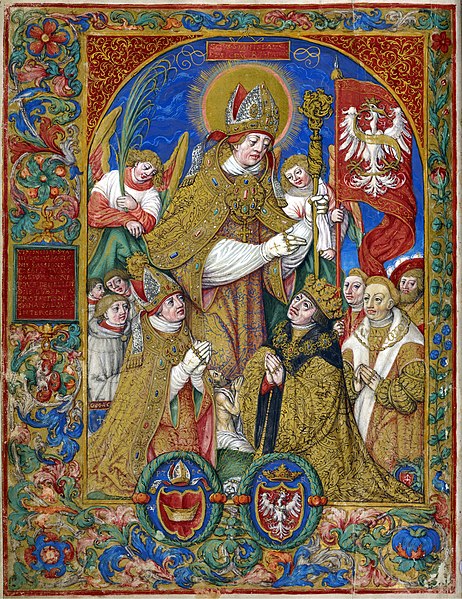The Renaissance in Poland lasted from the late 15th to the late 16th century and is widely considered to have been the Golden Age of Polish culture. Ruled by the Jagiellonian dynasty, the Crown of the Kingdom of Poland actively participated in the broad European Renaissance. The multinational Polish state experienced a period of cultural growth thanks in part to a century without major wars, aside from conflicts in the sparsely-populated eastern and southern borderlands. The Reformation spread peacefully throughout the country, and living conditions improved, cities grew, and exports of agricultural products enriched the population, especially the nobility (szlachta), who gained dominance in the new political system of Golden Liberty.
Copernicus' De revolutionibus orbium coelestium
King Sigismund I the Old and bishop Piotr Tomicki kneeling before St. Stanislaus, a leaf from the Hours of Sigismund I by Stanisław Samostrzelnik, 1535
Portrait of Queen Anna Jagiellon of Poland by Martin Kober, 1576
Graves of the last Jagiellons in the Sigismund's Chapel, hailed as "the most beautiful example of the Tuscan Renaissance north of the Alps"
The Polish Golden Age was the Renaissance period in Poland and the Grand Duchy of Lithuania, roughly corresponding to the period of rule of the King Władysław II Jagiełło (1386–1434) and Sigismund II Augustus, the last of the Jagiellonian Dynasty monarchs, until his death in 1572. Some historians argue that the Polish Golden Age continued into the mid-17th century, when the Polish–Lithuanian Commonwealth was ravaged by the Khmelnytsky Uprising (1648–57) and by the Swedish and Russian invasion. During its Golden Age, the Commonwealth became one of the largest kingdoms of Europe and at its peak stretched from modern-day Estonia in the north to Moldavia in the south and from Moscow in the east to Brandenburg in the west.
King of Poland and Grand Duke of Lithuania – Sigismund II Augustus and Queen of Poland, Grand Duchess consort of Lithuania – Barbara Radziwiłł in Vilnius by Jan Matejko.
Jagiellonian University in Kraków
Nicolaus Copernicus, one of the most important astronomers in history
Tapestry with shield-bearing satyrs and monogram SA of king Sigismund Augustus, ca. 1555








